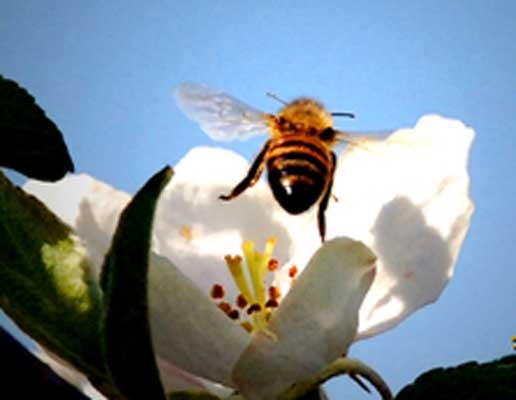Measuring movement of insecticides
Work at the Penn State Fruit Research and Extension Centre has measured the movement of most registered neonicotinoid insecticides into the pollen and nectar of apple from the pink (balloon) stage.
They found that some neonicotinoids are less toxic to bees than other compounds of the same class, as some are less systemic with little movement into the nectar and pollen.
They did find, however, higher levels of some fungicides in the nectar and pollen from the same pink application timing.
The term ‘higher’ is relative. A typical application of a neonicotinoid insecticide would be applied at 100-150 parts per million in the spray tank. Pollen and nectar samples taken five days later at about 25% bloom, however, were at the 1-5 parts per billion level. This is up to 100,000 times less than what was in the spray tank.
While in most cases, we know that these levels are below what is acutely toxic to the honey bee when exposed to this pesticide alone, it is not well understood how combinations of pesticides affect the long term chronic toxicity health of bees, and especially the other hundreds of species of native bees and pollinators.
Chlorpyrifos applied just before bloom is also very toxic to bees through its high vapour pressure ‘fumigating’ the orchard, and from residues on flowers in the ground cover.
The label allows pre-bloom sprays at least three days before bees are foraging.
Older products suspected synergists
What about Captan, Chlorothalonil and Mancozeb? All are old products that are still the mainstays of disease control and resistance management in many crops because they have multiple modes of action.
They are also not systemic, so the chances of the bees coming in contact with them from pre-bloom sprays are low and spraying at night to give the residues time to dry also helps reduce short-term toxic effects.
All of these products are suspected to be synergists for other pesticides.
Both captan and mancozeb are somewhat insecticidal by themselves at the high rates. This toxicity is thought to be from chronic long term ingestion and exposure of bees and other pollinators feeding on contaminated pollen during their development.
So what does all this mean?
It means that systemic insecticides and fungicides are likely to have a long term detrimental effect on bees and pollinators.
We need to protect our bees and pollinators— they are worth many millions to our industry.
Fortunately, we now have a risk management tool, Honeybee pesticide poisoning this booklet lists toxicities of primarily insecticides and miticides to bees.
Follow these guidelines and avoid the materials that are toxic to bees during bloom or when blooming weeds that bees visit are present in the orchard.
Consider if the pesticides are systemic or synergistic and their possible long term effects.
See this article in Tree Fruit August 2016






















